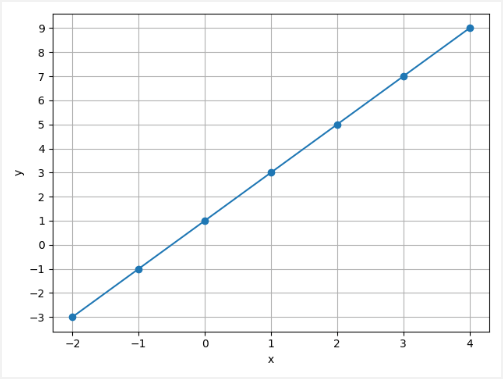Simple linear regression is a statistical method that is used to analyze the relationship between two continuous variables:
x- independent variable also known as explanatory or predictor.y- dependent variable also known as response or outcome.
Let's say we have the following sets of numbers:
| x | -2 | -1 | 0 | 1 | 2 | 3 | 4 |
| y | -3 | -1 | 1 | 3 | 5 | 7 | 9 |
You may notice that the x value is increasing by 1, and the corresponding y value is increasing by 2. So relationship is y = 2 * x + 1.

This tutorial provides example how to create and train a model which predicts the value of y for the given value of x using PyTorch.
We define arrays of x and y values for training a model. Model contains one layer. It has one input and one output.
We choose the mean squared error (MSE) as loss function and stochastic gradient descent (SGD) as optimizer. A learning rate is 0.01.
During training, we first zero the gradients to prevent accumulation from previous steps. We perform forward pass to compute predicted y values by using x values. The loss function is used to compute the error between the predicted and true values of y. After that, we perform a backward pass and use the optimizer to update the network weights. Training is performed 400 epochs.
import torch
xs = torch.Tensor([[-2.0], [-1.0], [0.0], [1.0], [2.0], [3.0], [4.0]])
ys = torch.Tensor([[-3.0], [-1.0], [1.0], [3.0], [5.0], [7.0], [9.0]])
model = torch.nn.Sequential(
torch.nn.Linear(1, 1)
)
loss_fn = torch.nn.MSELoss()
optimizer = torch.optim.SGD(model.parameters(), lr=0.01)
epochs = 400
for epoch in range(epochs):
optimizer.zero_grad()
ys_pred = model(xs)
loss = loss_fn(ys_pred, ys)
loss.backward()
optimizer.step()
x = torch.Tensor([[15.0]])
y = model(x).item()
print(y)When the training is completed, we try to predict a value of y for a previously unknown value of x. In our case, trained model returns y equal to 31.001181 when x is 15.0. We can verify:
y = 2 * x + 1 = 2 * 15 + 1 = 31



Leave a Comment
Cancel reply